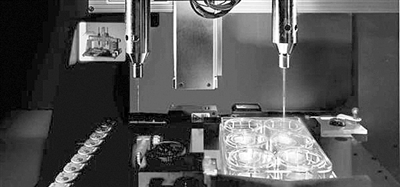

Contact: Manager Yang
Hotline: 950-4048-3964 (free)
Tel: 0510-85386636
Mobile: 18011518665
Shangmeng Technology Wuxi Co., Ltd.
Address: A1-602, Tianan Smart City, No. 228 Linghu Avenue, Xinwu District, Wuxi City, Jiangsu Province










information Technology
United States
The most dazzling chip research results of quantum computers
Liu Haiying (reporter of the newspaper in the United States) In 2017, the competition for quantum hegemony became hot, and Google and IBM launched the "big boss" status dispute. Google, which has launched a 9-bit computer, announced in April that it will launch a 49-bit processor at the end of the year; IBM will be the first to come, after pushing the "BM Q" system processor qubit to 16 bits in May, in November. Announced the successful development of 20 qubit processors, and said that it has built a 50 qubit processor prototype.
In addition to quantum computing, the results of several chip research also show that the United States' leading position in the field of information technology can not be shaken. Companies such as IBM and Intel are the most powerful promoters of technology. For example, IBM built a 5 nanometer chip and developed a 64-bit chip system that simulates the human brain neural network; Intel released a self-learning neural simulation prototype chip in August. Academic institutions are also unwilling to lag behind. For example, MIT has developed a new optical chip that can achieve efficient "deep learning", which is not only fast, but also low in energy consumption.
Germany
Established the largest IT research group in Europe to develop a quantum communication plan
Gu Gang (Reporter in Germany) The German Ministry of Education and Research announced two new IT and network-related plans in 2017 to implement the EU's cybersecurity strategic goals. First, three information technology security research centers will be established: Darmstadt's Center for Information Technology Security, Privacy and Responsibility, Saarbrücken Security and Privacy Research Center, Karlsruhe Center for Applied Security Technology Competence. The three largest IT security research clusters in Europe make more innovative companies stand out and strengthen Germany's digital sovereignty. The second is to announce the development of a quantum communication program that uses a single light particle to process and transmit information to create a highly secure quantum communication network.
Many new achievements have been made in the field of information technology. For example, scientists at the Helmitz Materials and Energy Research Center in Berlin have completed lithographic nanostructures on the bottom of silver materials for the first time. Silver nanostructures are quite large in the field of electronics and information technology. Application potential, complex silver nanostructures can be used as the basis of pure optical data processing, opening up new avenues for future optical computer data processing and new electronic device manufacturing.
In order to make electronic components more miniaturized, connecting circuits at the nanoscale level requires extremely fine molecular wires. Experts from the University of Keele and the International Physical Research Center of Spain have developed single-molecule wires with only atomic diameter. This is only two. A molecular conductor having an atomic bond length and an atomic width functions as a nanoswitch in an electronic device.
France
The government attaches importance to information technology innovation digital economic strategy
Li Hongce (Reporter of the newspaper in France) President Mark Long served as the Minister of Digital Innovation and attached great importance to the development of the digital economy and information technology. After the election of Mark Long, he immediately boldly opened the 33-year-old Ma Zubi as the state secretary in charge of digital technology, and set out to develop a long-term plan to vigorously develop the French digital economy.
France announced the "French International Strategy in the Digital Field" at the end of the year, proposing that it will vigorously promote French digital companies to go out of France and the EU, open up the international market, and France will continue to promote diversification of international Internet management. The strategy plans France's principles and goals for future implementation and development in the areas of Internet governance, digital economy and cybersecurity, with the aim of increasing France's international influence in the digital arena.
In addition, in order to encourage more information technology talents to innovate and start a business, France launched the operation of Station F, the world's largest startup park this year. Located in the 13th arrondissement of Paris, the park covers an area of 34,000 square meters and can accommodate thousands of startup companies. At present, information technology giants such as Google and Facebook and many digital innovation companies have settled in the park.
Russia
5G network construction accelerates pace, smart city has achieved remarkable results
Yan Kewei (Reporter in Russia) At present, Russia is accelerating the construction of 5G communication network. The capital city of Moscow has become one of the most developed mobile communication markets in the world. The Moscow City Government plans to establish alliances with major mobile operators to jointly develop 5G technologies. During the 2018 Football World Cup, Megafon plans to arrange a 5G network test area in Moscow and St. Petersburg. Russian 5G technology standards are expected to come out in 2020, and Chinese companies including Huawei will play an active role in the development of new standards.
Significant results have been achieved in the construction of smart cities in Moscow. In 2017, Moscow City integrated the subway and ground public transport WiFi network to provide free Internet access for passengers. The mobile public transportation navigation application can obtain all bus routes and calculate the travel cost, and has the functions of recharging the three-in-one bus card, checking the payment history, inquiring about the parking lot near the subway station and the remaining parking spaces. Some smart bus stations in the city center are equipped with USB charging piles, WiFi access points, electronic vehicle display, emergency alarm button and surrounding information query touch screen.
In 2017, Russian IT product exports grew rapidly, with exports exceeding the $7 billion mark. Exported software products are mainly concentrated in the fields of information security, mobile phone programs, navigation and geographic information systems, and file transfer systems. St. Petersburg actively builds a computing technology industry cluster and a Russian modern computing technology professional center, which is expected to receive a project subsidy that accounts for 50% of its total R&D investment. According to the "Russian Development Plan for the Electronics and Radio Industry before 2025", the domestic market share of Russian IT equipment is expected to rise to 35% by 2025.
Korea
The world's first in the world
According to an authoritative survey report, the average Internet speed in South Korea in 2017 was 28.6 megabits per second (Mbps), ranking first in the world for many years and the only country with more than 25 Mbps. The network penetration rate is also ranked first, with a network penetration rate of over 10 Mbps of 98% and a penetration rate of 40% above 25 Mbps.
The Korean government has more than 6.04 million IoT users, accounting for more than 10% of wireless data users.
The Ministry of Economic Affairs and Self-Government of Korea and the Information Technology Promotion Agency jointly released the "10 Technology Trends of E-Government in 2017" report, announcing the e-government to gradually develop into a data-centric government that combines data analysis and robotics to provide more thoughtful services. ".
South Korea announced that it will launch the 5G network for the first time in the 2018 PyeongChang Winter Olympics, launching a number of new applications based on the Internet of Things, UHD, AI and VR.
In addition, SNUver, a driverless car developed by Seoul National University, completed the actual road test run. LG Electronics successfully developed LTE-based car networking terminals and self-driving car safety technology.
United Kingdom
5G development keeps leading and strengthens personal data protection
Zheng Huanbin (Reporter in the UK) To ensure that the UK maintains a leading edge in 5G development, the UK will invest £16 million to establish a nationwide “5G Innovation Network” to test new technologies related to 5G. In addition, the government will invest 200 million pounds to build a high-speed, reliable fiber-optic broadband network locally.
The British government announced in August that it will amend the relevant provisions of the Data Protection Act to strengthen the protection of personal data privacy. Individuals will have greater control and processing power over their own data. The process by which organizations collect personal data is also regulated more rigorously. The UK Information Authority will take on more responsibilities to protect the interests of consumers and issue fines for illegal agencies, up to a maximum fine of £17 million or 4% of the global turnover of illegal institutions.
Israel
Promote biometric cybersecurity initiatives
Mao Li (Reporter to Israel) The Knesset passed a bill: All Israeli citizens will have to use a biometric ID card whose personal information (information, fingerprints, photos and facial features; cardholder name, gender and date of birth) will be Stored in the national database. However, fingerprint information is optional.
In terms of network security, US network security company Optiv will use the network intelligence collection technology developed by Israeli network security startup Intsights to provide customers with a new predictive cyber threat intelligence service; Enter Unbotify's products use biometric behavior technology. The attacker is a robot or an automatic program by determining the duration of the button, the way the mouse is moved, and the device holding mode, thereby reducing the success rate of the network attack.
Imperva's research found that hackers don't pay much attention to hiding the traces of their attacks, and most hackers are unable to steal user data in a timely manner within 24 hours due to the complexity of the information. Therefore, users are expected to prevent hackers from launching substantive attacks by quickly changing passwords. .
Any image video that people download or use to stream data can be a potential carrier for cyber attacks, but a series of algorithms developed by Ben Gurion University can "completely prevent" attackers from monitoring user behavior with video or image downloads.
In addition, Precognize uses artificial intelligence to analyze the large amount of data collected from sensors and automatically convert the data into specific early warnings, thereby reducing the loss of plant equipment during operation.
Japan
Inventing the large-scale algorithm of optical quantum to realize the maximum capacity transmission of optical fiber
Chen Chao (Reporter in Japan) Professor Gu Zeming of the University of Tokyo invented the method of optical quantum computer that uses a minimum-scale circuit structure to efficiently perform large-scale calculations by using a method of connecting a series of light pulses on the optical path. This method can theoretically handle large-scale operations of more than 1 million qubits, which can promote the large-scale production of optical quantum computers, while greatly reducing the resources and costs required, and is expected to bring innovation to optical quantum computers.
The fiber achieves maximum capacity transmission. In August, NTT, KDDI, Sumitomo Electric and other organizations achieved the world's largest data capacity transmission of 118.5 Tb per second using multi-core fiber with the same diameter and existing four optical paths. The fiber technology is expected to be put into practical use in the early 2020s.
Bass
Push the “National Internet of Things Program” to start 5G network construction
Deng Guoqing (Reporter in Brazil) In 2017, the development of the Internet of Things in Brazil initially had a certain technology, industry and application base, showing a good development trend. Brazil has achieved many results in technological research in the fields of chips, communication protocols, network management, and collaborative processing. Progress has been made in the research of sensor network interfaces, identification, security, sensor network and communication network convergence, and IoT architecture. The Internet of Things has made great progress in the fields of industrial development, technology research and development, standard development and application development. Brazil is actively planning and constructing the “National Internet of Things Program”, focusing on the development of manufacturing industries closely related to the perception function of the Internet of Things, promoting the high-end development of core manufacturing technologies such as sensors and 2D barcodes, and promoting supporting industries such as instrumentation and embedded systems. The improvement of capabilities has promoted the development and growth of micro-nano devices, integrated circuits, new materials and other industries. At the same time, the government is committed to fostering the Internet of Things service industry. Encourage innovation in operational models, vigorously develop new services such as professional services and value-added services that are conducive to expanding market demand, and promote the rapid development of unique markets created and derived by IoT applications.
According to survey data released by Brazil Mobile Network Service Analysis, only 55.29% of the domestic mobile phone users in Brazil can use 4G networks in 2017, and most people use 2G and 3G networks. Despite the limited development of the Internet market in Brazil, Brazil is still regarded as an Internet market with great development potential and strategic significance because of its huge network of Internet users and strong Internet demand. In February 2017, the Brazilian government officially decided to implement the 5G network plan project in Brazil and set about promoting the construction of mobile ecosystem in Brazil.
Advanced manufacturing
United States
"Made in the United States" is initially effective in artificial intelligence fusion manufacturing
Liu Haiying (Reporter in the United States) In 2017, the US manufacturing innovation system continued to develop. The 14 innovation centers under the “Manufacturing America” project covered many hotspots in the current advanced manufacturing industry, and its operation achieved initial success.
3D printing technology has a solid leading position and is gradually covering the medical, aerospace and military industries. For example, in August, American scientists successfully used 3D technology to create a variety of polymer alloy objects in the thermal vacuum chamber, which indicates that the application of space 3D printing technology is promising. In November, American scientists 3D printed high thermal conductivity fabrics, which further expanded the The application space of technology.
The integration of artificial intelligence technology into advanced manufacturing has become a new hot spot. New robots that incorporate multiple manufacturing technologies are constantly refreshing expectations for artificial intelligence. A software robot developed by Harvard University and Boston Children's Hospital can help the heart beat and pump without contact with blood. The new intelligent gripper designed by Stanford University scientists can shape different shapes under space microgravity. The object is caught freely.
Japan
Artificial intelligence results continue to be a hot spot for human-computer collaboration
Chen Chao (this reporter in Japan) uses machine learning "migration learning" technology to effectively determine the interface structure, and is expected to speed up the development of materials. The University of Tokyo has enabled artificial intelligence to “reproduce the growth” and successfully reduce the computational complexity of the material interface structure to the original 1/3600. The interface plays an important role in many materials currently used in industry. Determining an interface requires thousands of tens of thousands of theoretical calculations. Understanding its structure and function is an essential factor in improving the speed of material development.
Developed a self-growth voice dialogue artificial intelligence technology. In September, Hitachi, Ltd. developed a self-growth voice dialogue artificial intelligence technology for the humanoid robot EMIEW3. When EMIEW3 is unable to answer the guest's questions, the Employees can understand the meaning of the guest by simply confirming the staff and answering them.
Japan's Yaskawa Electric and Mitsubishi Electric launched new products and solutions at the 2017 International Robot Show in Tokyo, indicating that human-machine collaboration robots, artificial intelligence robots, and smart factory integrated solutions have become the focus of research and development in the robot industry.
Germany
3D printing for breakthroughs in energy laser technology
Gu Gang (this reporter in Germany) has successfully introduced 3D printing technology in the field of energy production. Siemens used 3D printing technology to manufacture gas turbine blades and conducted full-load operation tests. The tests show that 3D printed turbine blades are fully compliant with gas turbine operating requirements. Engineers have developed material solutions for gas turbine blades, optimized manufacturing and installation processes, and completed the entire production chain from component design, material selection, quality control and simulated component life.
3D printing technology has also made breakthroughs in other fields. German scientists use standard 3D printing technology to create ultra-complex, high-definition and high-quality glass shapes. This means that 3D printing technology has been able to fabricate structures with higher optical properties, and it is expected to be widely used for designing complex lenses and filters.
The smallest linewidth laser has been available to date. The German Federal Institute of Physics and Technology and the United States Astrophysics Joint Laboratory have developed a 10 megahertz minimum linewidth laser in the world. The best lasers today have linewidths down to kilohertz, but still do not meet the requirements of precision instruments such as optical atomic clocks. The new megahertz lasers can produce more accurate atomic clocks and make more accurate measurements of ultra-cold atoms. .
Russia
3D printing engine parts AI achievement voice assistant
Yan Kewei (Reporter in Russia) 3D printing, scientists at the Russian National University of Russia are working on 3D printing of ceramic materials for a new generation of helicopter engines. Parts made with new technology are resistant to high temperatures and withstand physical shocks. It has advantages in terms of pressure and chemical resistance.
In terms of artificial intelligence, Russia's Yandex announced that it is developing an artificial intelligence voice assistant called Alice, which will compete with Google's Home and Amazon's Echo in the international market in the future. Alice's artificial intelligence voice assistant will integrate all of Yandex's services, so users don't have to waste time viewing hundreds of applications.
In addition, the National University of Southern Ural created a trial version of the artificial neural network system, which can recognize human psychology according to Jung's psychological type theory, and then assign suitable jobs according to the psychological characteristics of job seekers. Provided to the personnel department or psychologist of a large enterprise for trial use.
Israel
Artificial intelligence is on the verge of many applications
Mao Li (Reporter in Israel) Israel's artificial intelligence application development is in full swing: shorten the software production cycle; combine 3D imaging technology to help customers choose shoes; elderly people living alone can have "life partner" robots; intelligent "cat eyes" provide two-way traffic information.
Dragonera's use of artificial intelligence and microservices reduces the software production cycle to 14 to 45 days, reducing the chances of software dying due to lack of funds or long expiration. Customers can monitor product development progress and participate in product architecture and design.
Using artificial intelligence and 3D imaging technology, Invertex's application, by scanning the foot with a smartphone, analyzes the size of the user's foot to know the model and size of the shoe that best suits you.
Using artificial intelligence robot companion Elli, Intuition Robotics has integrated its cognitive computing, natural communication technology, speech recognition technology and computer vision technology to enable it to actively interact with the elderly and provide activity suggestions to become a "life partner".
Using artificial intelligence algorithms combined with communication systems, Valerann has developed a smart road stud (cat's eye) control system with sensors that can be placed on the road and provides two-way feedback between the user and the control center to help build a smart city. (This version of the image comes from the network)
Address:Tianan Smart City A1-602, No. 228 Linghu Avenue, Xinwu District, Wuxi, Jiangsu, China TelePhone:0510-85386636 Fax:0510-85384339 E-mail:info@solmontech.com
KeyWord: